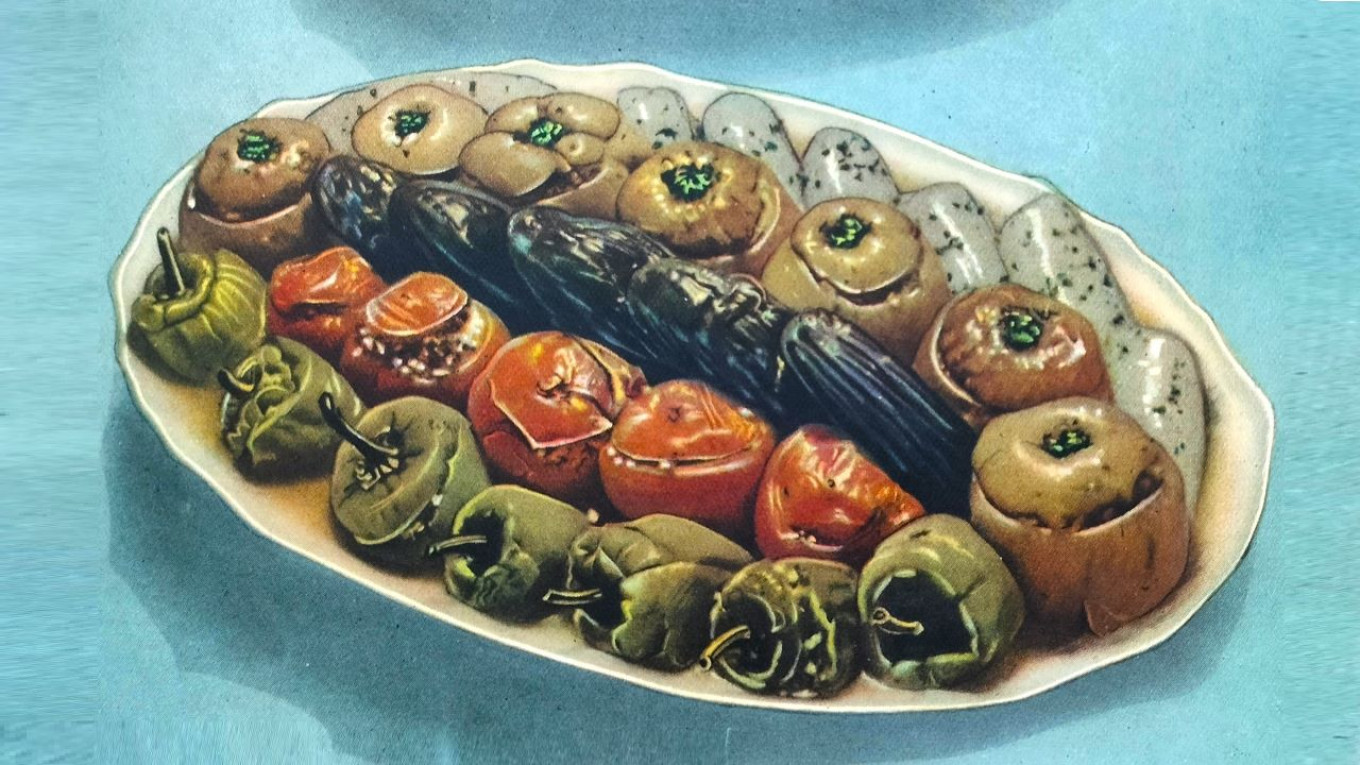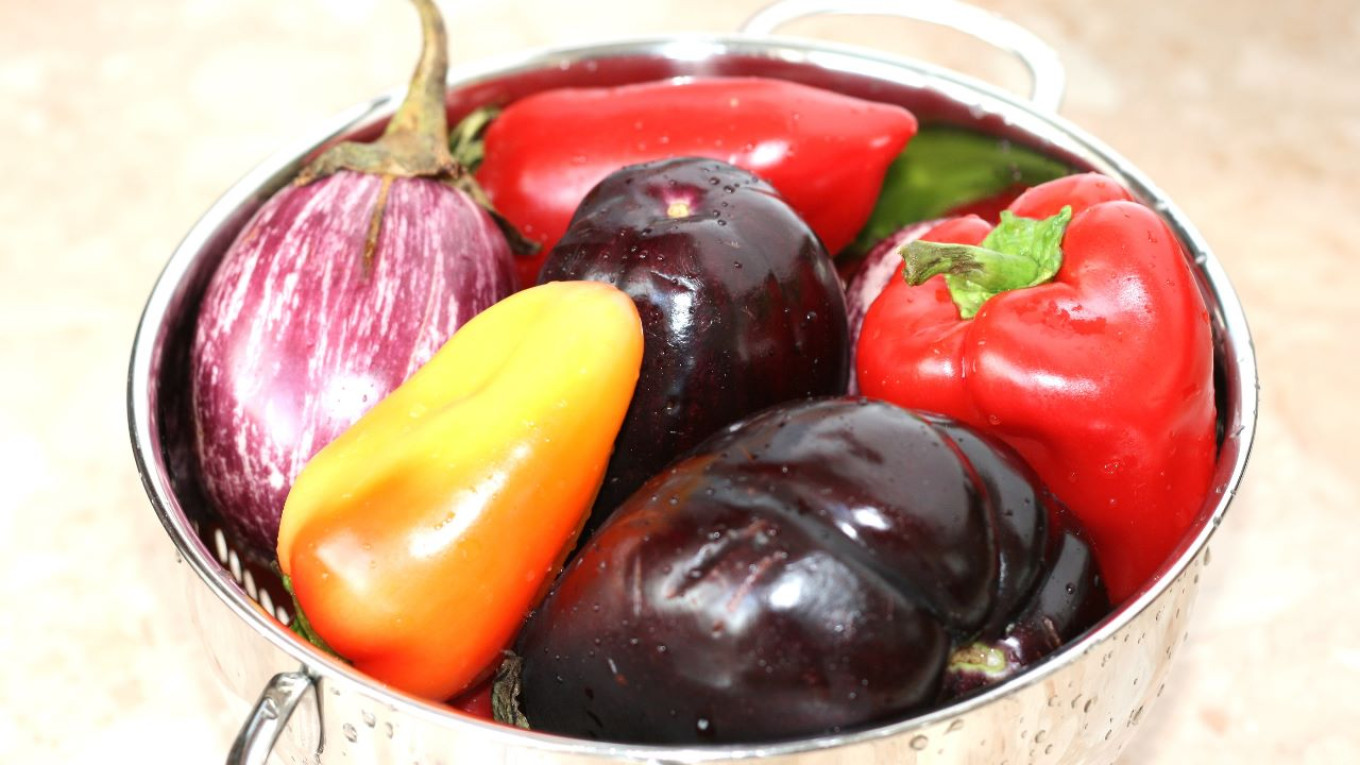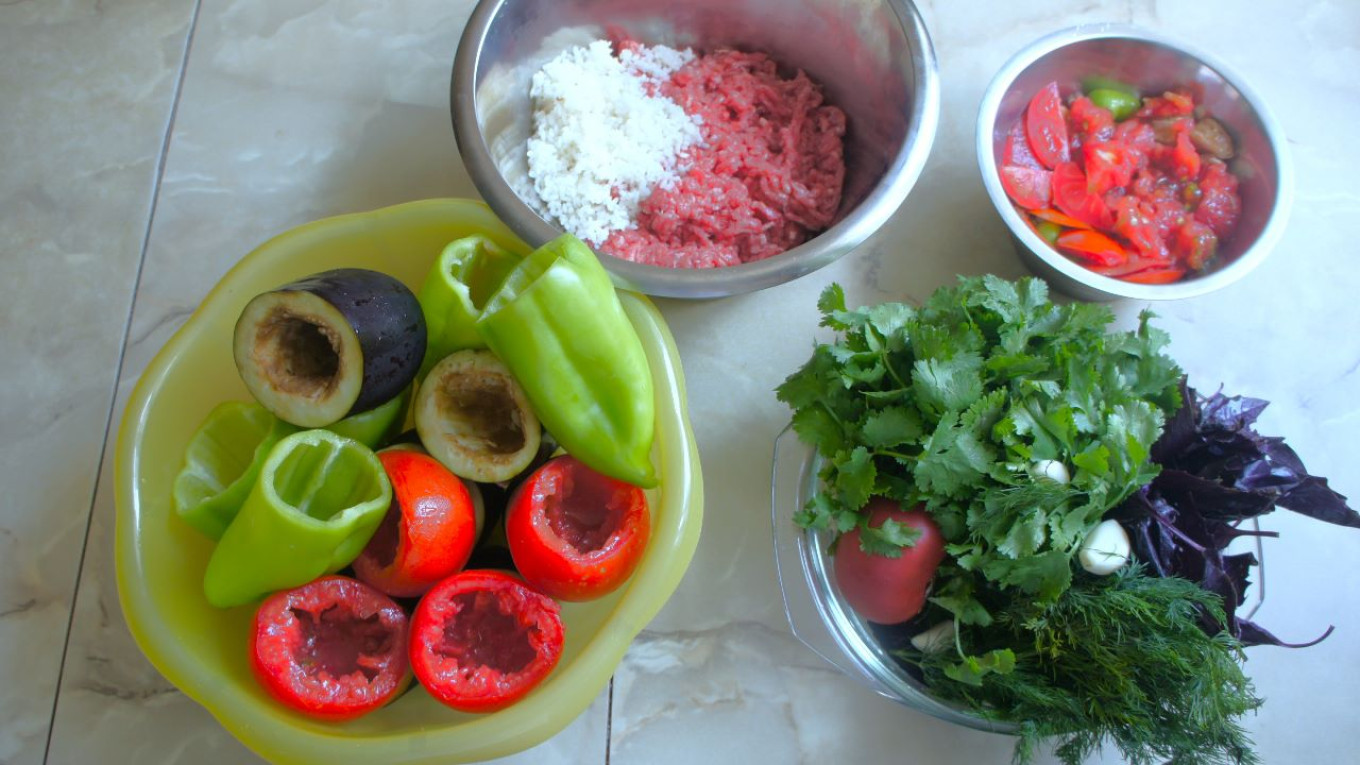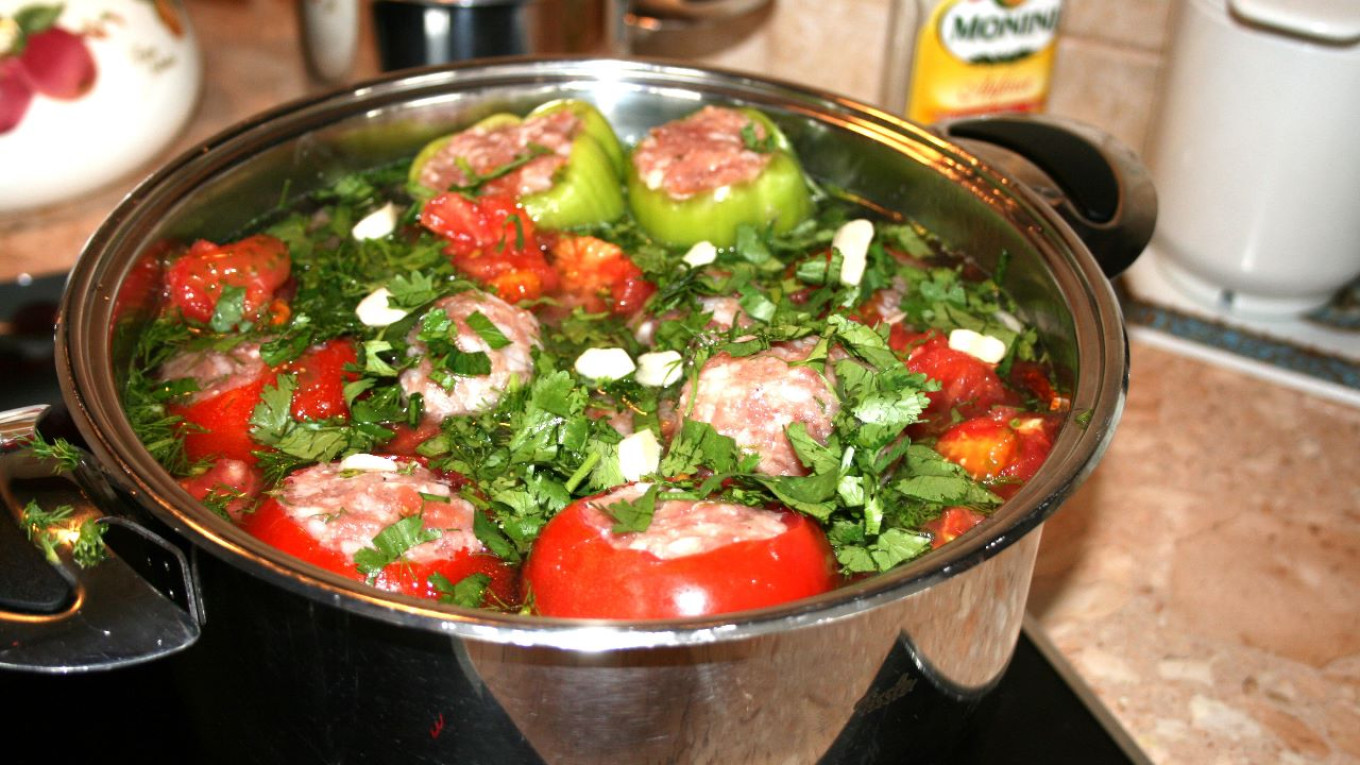Now that summer is truly here, the first locally grown peppers, tomatoes, and eggplants are appearing in the markets. The end of June is the perfect time to make stuffed vegetables.
In the Caucasus, all vegetables, cabbage and vine leaves stuffed with meat are called "dolma." We call our stuffed cabbage leaves golubtsy (“little pigeons”) and our stuffed grape leaves and vegetables “dolma.” When we were children, we loved this picture from the 1955 Soviet cookbook "Kulinariya."

But stuffed vegetables are by no means an exclusively Caucasian tradition — far from it! In Russia all the great chefs and culinary specialists made them. The works of Gerasim Stepanov, the author of several very interesting cookbooks in the mid-19th century, even included stuffed artichokes.
Stuffed turnips were quite a common dish on the Russian table in the past. "Boil turnips,” writes Stepanov, “then peel and scoop out the flesh. Mix the turnip flesh with rice and raisins. Add 2 raw eggs, butter, mix and stuff the peeled turnip. Top with cheese and put it in the oven."
But turnips are rather heavy, good to eat on cold winter days. Now it's time for lighter vegetables — peppers, eggplants, tomatoes — that seem to reflect the southern sun. By the way, a look at the history of these vegetables in Russian confirms what a cold and harsh climate Russia has. They all appeared in Russia fairly recently.
Tomatoes have had a fraught history in Russia. This American fruit is certainly not indigenous to Russia, but “love apples” — what tomatoes were called in the past — came to Russia very late, only at the end of the 18th century. But they were not immediately welcomed at the table. The famous Russian botanist Andrei Bolotov wrote in 1784 that tomatoes were grown in many places (referring to Central Russia) in hothouse conditions, in pots, mostly as an ornamental plant.
In the north of Russia, they were used only as an indoor ornamental plant. But at the end of 18th century the Russian and German naturalist Johann Gottlieb Georgi noted that “in southern Russia, Astrakhan and Tavrida, Georgia love apples are frequent found in outside gardens.” In Astrakhan and Georgia "ripe tomato fruits are eaten like cucumbers, served with vinegar and Spanish pepper."
Tomatoes as food spread quickly. By the mid-19th century they were grown as food in the Crimea, Moldova, Odesa, Mykolaiv,Kherson, and in the Caucasus. By the 1880s tomatoes had appeared in the gardens of Kostroma, Vyatka, and Vologda provinces, as well as in Belarus.
But when we go back to first-hand sources, tomatoes were completely exotic in our cuisine even in the second half of the 19th century. Take "Russkoye Slovo" magazine in 1859. One of the publication’s correspondents is in France and sending a report from Marseilles. He is quite shocked by French manners:
"Here men and ladies bathe in the sea right next to each other, almost together. From 4 to 7 p.m. every day one can watch the ladies, wearing dark blouses, bathe in the sea. The sloping shore is the amphitheater: spectators sit on it and calmly smoke cigars. The ladies are not the least bit embarrassed. In the outskirts of Paris I saw men on public boat trips strip down in the presence of the ladies and, wearing only their underwear, jump into the Seine.”

But the journalist was not distracted by French frivolity for long. He continued his quest for knowledge, but the sea air piqued his appetite and he went to a local restaurant.
"Yesterday they served me something red floating in olive oil. ‘What is it?’ I asked. ‘A tomato, monsieur, a love apple.’ I liked the love apple very much — both its name and its flavor.”
At the end of the 18th century in Russia these pommes d'amour (love apples) were used as a medicinal plant, its flowers decorated ball gowns, and witches even used it in their spells.
We recently wrote about how cultivated peppers appeared in Russia in an article about General Skobelev. Thanks to him and Bulgarian settlers, sweet peppers were brought to Tashkent — and to this day are called “Bulgarian peppers.” In the mid-19th century, eggplants were called “Armenian cucumbers” in Russia. We can see how quickly people accepted these once exotic products and made them part of our cuisine.
The dish that we like to cook in June may be called dolma, or it may be simply called stuffed vegetables. The first pleasure begins when you go to the farmer’s market to buy all the gorgeous vegetables.

Dolma: Herby, Spicy Stuffed Vegetables
Ingredients
- 6 peppers
- 6 firm tomatoes
- 6 eggplants
- About 400 g (1 scant lb) each beef and pork, or a mix of beef, pork and lamb
- 2 medium onions
- 3/4 cup rice
- 600-700ml (2/3 to2/3 liter) meat broth
- Medium bunch of cilantro
- Purple basil
- Young garlic

Instructions
Notes: You can use any meat you wish, but it is delicious when made from a mix of three kinds of meat: pork, beef and lamb.
The rice should be par-boiled in a large quantity of water, sieved in a colander and left to cool.
- Remove the seeds and membranes from the peppers, cut the eggplant in half (crosswise) and scoop out the flesh. Cut the “lid” off the tomato (just under the stalk) and gently use a spoon to scrap out the pulp and juice in a bowl for later use. Peel and slice 5 cloves of garlic. Chop the coriander and basil.
- Prepare the stuffing: run the meat and onion through a meat grinder. With a fork, mix the meat, onion, rice, ¼ of the chopped coriander and a pinch of basil. Salt and pepper to taste.
- Stuff the vegetables and place them in layers in a pot: peppers on the bottom, then eggplants, and tomatoes on top. Sprinkle the herbs and garlic on top of each layer, but be sure to keep some as a garnish.
- Mix three cups of broth with the pulp from the tomatoes, salt to taste and pour over all the vegetables. If you prefer, you can use warm water mixed with the tomato pulp or vegetable broth. We like it spicier — we add hot chili pepper.

- Bring to a boil, turn down the heat, and cook on medium heat for about 1 hour. When ready, sprinkle all the remaining herbs and garlic on top. Cover, remove from the stove and let "rest" for 10 minutes. If you like, you can serve with sour cream.
A Message from The Moscow Times:
Dear readers,
We are facing unprecedented challenges. Russia's Prosecutor General's Office has designated The Moscow Times as an "undesirable" organization, criminalizing our work and putting our staff at risk of prosecution. This follows our earlier unjust labeling as a "foreign agent."
These actions are direct attempts to silence independent journalism in Russia. The authorities claim our work "discredits the decisions of the Russian leadership." We see things differently: we strive to provide accurate, unbiased reporting on Russia.
We, the journalists of The Moscow Times, refuse to be silenced. But to continue our work, we need your help.
Your support, no matter how small, makes a world of difference. If you can, please support us monthly starting from just $2. It's quick to set up, and every contribution makes a significant impact.
By supporting The Moscow Times, you're defending open, independent journalism in the face of repression. Thank you for standing with us.
Remind me later.







